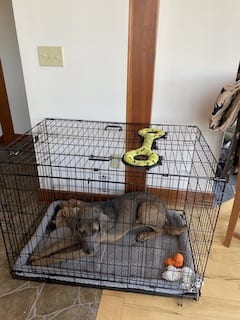
Adopting a foster dog
Last year, Keith and I adopted a foster dog who’d been rescued then cared for at our local shelter and fostered at a local day camp, training, and boarding facility. We named him Cato. When we first brought Cato home, he pulled on his leash and jumped on us despite our “off” commands. He chewed on Heathcliff and Freya’s ears, legs and tails despite their warning growls. And he lunged for food, climbed on furniture and into our laps, and messed inside the house.
Caring for a foster dog

Here are some of the tips from the people at our local shelter Almost Home:
- Keep your new dog’s world small at first, and only use one door as the “in and out” door.
- Create a private, safe spot for your dog to retreat to, preferably in the main family room.
- Be consistent with commands; you are the pack leader, and dogs look for leadership.
- Teach your dog and visitors, especially children, how to meet and greet.
- If you have other pets, feed them first and give them better treats; it usually takes a few days or longer for dogs to get to know each other.
- Play with your dog, but do not allow teeth or mouthing.
- Buy a can of Enzyme cleaner; even house-trained dogs can mess inside their new homes.
There’s a saying about rescue, shelter, and foster dogs: “Three days, three weeks, three months,” and for Cato this was particularly true. The first three days were very stressful for him—and us. By the end of three weeks, he’d settled down considerably, well on his way to becoming a mission-driven guard dog. And after three months of routine, he was part of the pack.
He asked to go outside when he needed to relieve himself and did his “hurry up” before bedtime. No more messes. He walked calmly on leash—thanks in part to a training collar—ran the mountain and came home when called, and waited for his food. He’s our most affectionate pup but still fears the inside stairs; we’re working with him, and he’s making progress.
Adjusting to the loss of a mentor

Heathcliff was Cato’s buddy; wherever Heathcliff went, Cato had to go, too. But Cato knows Heathcliff isn’t here anymore. And Cato is grieving in the following ways:
- Lack of appetite: he sits, drooling for his food, but has to be coaxed to eat.
- Lethargic behavior and sleeping more than usual: he spends a lot of time in his crate.
- Searching for the companion dog; he wanders around their old stomping grounds.
- Becoming very clingy: he asks for affection often and follows us around.
We’re paying extra attention to Cato, and Freya, too. Now that she’s the alpha dog, she gets treats first, and I take her along when I drive him to the doggie day camp where he was fostered. They both love rides in the car. And while Cato runs and plays with his friends, Freya gets some peace and quiet—so do we.
Foster dog Cato is a lot of work. And a huge blessing.



0 Comments